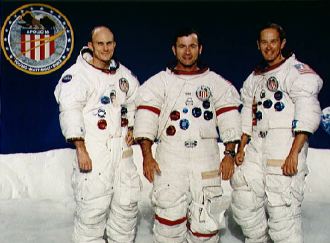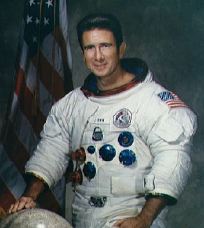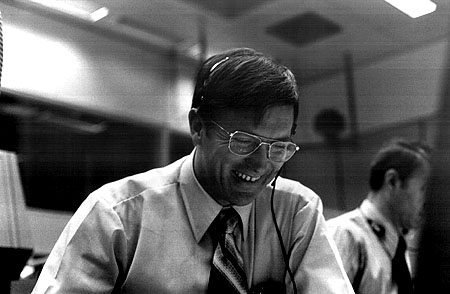
| Journal Home Page | Apollo 16 Home Page |
Corrected Transcript and Commentary Copyright © 1995 by
Eric M. Jones.
All rights reserved.
Last revised 5 January 2006.

Apollo 16 Crew Portrait
Mission Commander
John Watts Young, Commander, USN

John was born on September 24, 1930 in San Francisco, California. He was educated as an Aeronautical Engineer, receiving a bachelor's degree from Georgia Tech in 1952. After graduation, he joined the U. S. Navy and began flight training a year later. In 1959, he graduated from the U. S. Navy Test Pilot School.
John was selected as a member of the second group of pilot-astronauts in 1962, and was the first of the group to be assigned a mission. He flew with Gus Grissom on Gemini 3 and later as Commander of Gemini 10 with Michael Collins. He then served as Command Module Pilot on the Apollo 10 lunar mission and backup Commander on Apollo 13 before landing on the Moon with Charlie Duke on Apollo 16. He and Duke also served as the backup LM crew for Apollo 17.
In 1975, Young became the Chief of the Astronaut Office but remained active in development and testing of the Shuttle. He flew as Commander of the first Shuttle flight in April 1981 and flew his sixth space mission in November 1983 as Commander of STS-9. John retired from NASA on 31 December 2004 after serving eight years as Associate Director (Technical), responsible for technical, operational and safety oversight of all Agency Programs and activities assigned to the Johnson Space Center.
- NASA photo S71-51261 is John's Apollo 16 portrait.
Command Module Pilot
Thomas K. (TK) Mattingly, II, Lt. Commander, USN

TK was born on March 17, 1936 in Chicago, Illinois. He was trained as an aeronautical engineer at Auburn University, receiving his Bachelor's Degree in 1958.
At the time of his selection as a member of the fifth group of astronauts, TK was a student at the USAF Aerospace Research Pilot School at Edwards AFB. He served as a member of the support crews for Apollo 8 and 11 and played an important role in the development of the Apollo spacesuit and backpack. Although he was never officially named as a member of the Apollo 11 backup crew, when the original backup Command Module Pilot, Bill Anders, accepted a job at the White House and began to spend increasing amounts of time in Washington, Mattingly began to train in his stead and participated as backup CMP in most of the integrated (full-up) simulations run in the final months before the Apollo 11 launch. He was selected as Command Module Pilot (CMP) for Apollo 13 but was removed from the crew three days prior to launch because of exposure to German measles. The backup CMP, Jack Swigert, took his place and Mattingly subsequently flew as CMP on Apollo 16 with Young and Duke.
From 1973 until 1978, Mattingly served as the head of the astronaut support team for the Shuttle program and then served as backup Commander for the second and third missions. In June 1982, Mattingly made his first Shuttle flight as Commander of the fourth mission (STS 4) and, then, in January 1985, commanded the 15th mission, STS-51C. After leaving NASA, he served as Director, Space Sensor Systems, U.S. Navy Space and Naval Warfare Systems Command; and later served as Director, Utilization and Operation, Grumman Space Station Program Support Division, Reston, Virginia.
- NASA photo S71-51295 is Ken's Apollo 16 portrait.
Lunar Module Pilot
Charles Moss Duke, Jr., Lt. Colonel, USAF

Charlie was born in Charlotte, North Carolina on October 3, 1935. He graduated from the U.S. Naval Academy in 1957 and then joined the U.S. Air Force which had not yet graduated a class of young officers from its own Academy. After completion of flight training, he served as a fighter interceptor pilot in Germany, and then attended the Massachusetts Institute of Technology, receiving a Master's Degree in Aeronautics in 1964. The following year he graduated from the Air Force Aerospace Research Pilot School and was serving as an instructor when, in April 1966, he was one of 19 pilots selected in the fifth group of astronauts.
Charlie served as CapCom during the Apollo 11 landing and as Lunar Module Pilot with Young on the backup crews for Apollo 13 and 17 and on the Apollo 16 prime crew. Duke retired from the Astronaut Corps in 1975 and, later from the U.S. Air Force as a Air Force Reserve Brigadier General. He became active in private business and as a Christian lay witness.
- NASA photo S71-51289, is Charlie's Apollo 16 portrait.
LM Landing and Launch CapCom
Col. James B. Irwin, USAF (Retired)

Personal: Jim was born on March 17, 1930, in Pittsburgh, Pennsylvania. He died on August 8, 1991 of a heart attack. He was married and he and his wife, Mary, had five children (one adopted).
Education: B.S., U.S. Naval Academy, 1951. M.S. in aeronautical and instrumentation engineering, University of Michigan, 1957.
Spaceflights: Lunar module pilot, Apollo 15 (1971).
Jim was chosen with the fifth group of astronauts in 1966. He served as the backup lunar module flight pilot for Apollo 12 and as the lunar module pilot for Apollo 15 (eighth man to walk on the Moon). He retired from NASA and the Air Force in July 1972 to form and lead a religious organization, High Flight Foundation, in Colorado Springs, Colorado.
His book, To Rule the Night, describes his early life, selection into the astronaut program, and his experiences on Apollo 15. Jim is buried at Arlington National Cemetery.
- NASA photo S71-56478 is Jim's formal Apollo 15 portrait.
EVA CapCom
Anthony Wayne (Tony) England, Ph.D. civilian

Tony was born May 15, 1942 in Indianapolis, Indiana. He is married and has two children. He earned his B.S. and M.S. degrees in Earth Sciences from the Massachusetts Institute of Technology (MIT) in 1965, and a Ph.D. in Geophysics from MIT in 1970. He was chosen with the second group of scientist-astronauts in 1967. He served as Apollo 13 Mission Scientist and was slated to serve as EVA CapCom on Apollo 13. Later, he served as Mission Scientist and EVA CapCom on Apollo 16. He resigned from NASA in 1972 and served as a Research Geophysicist and Deputy Chief of the Office of Geochemistry and Geophysics during seven years with the U.S. Geological Survey. He then returned to NASA in June 1979 and flew as a Mission Specialist on the Spacelab 2 shuttle flight in 1985. He as Program Scientist for Space Station in 1986-87 and then served as a visiting Adjunct Professor at Rice University before joining the University of Michigan, Ann Arbor, in 1988. As of the late 1990s, he was Professor of Electrical Engineering and Computer Science; Professor of Atmospheric, Oceanic and Space Science; and Associate Dean of the Rackham School of Graduate Studies. He teaches electromagnetics and remote sensing geophysics. His research has spanned scattering theory as applied to radio emitters, the development and application of ice-sounding radar for the study of glaciers in Alaska and during two field seasons in Antarctica, and, currently, the assimilation of satellite microwave data in Land-Surface Process models. He has been an Associate Editor for the Journal of Geophysical Research; is a member of the National Research Council's Space Studies Board, and has served on several federal committees concerned with Antarctic policy, nuclear waste containment, and federal science and technology. He is a Fellow of IEEE and a member of the American Geophysical Union.
- NASA photo S72-38436 is a good portrait of Tony at the CapCom console.
| Journal Home Page | Apollo 16 Home Page |